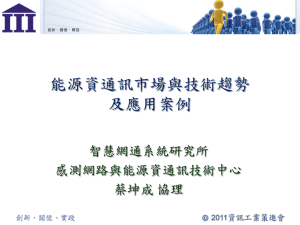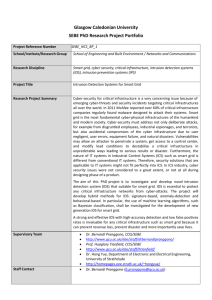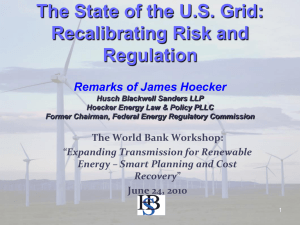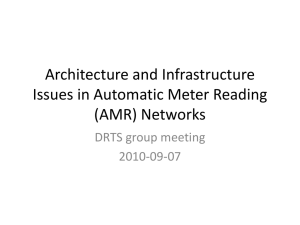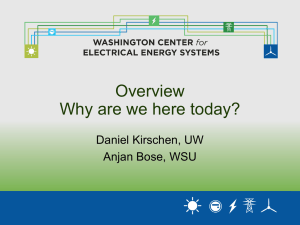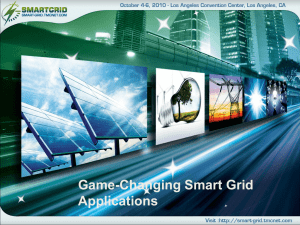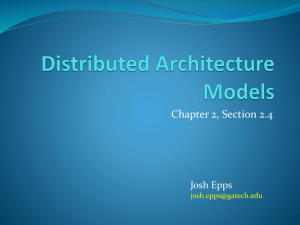Smart Grid Projects at Automation & Control
advertisement
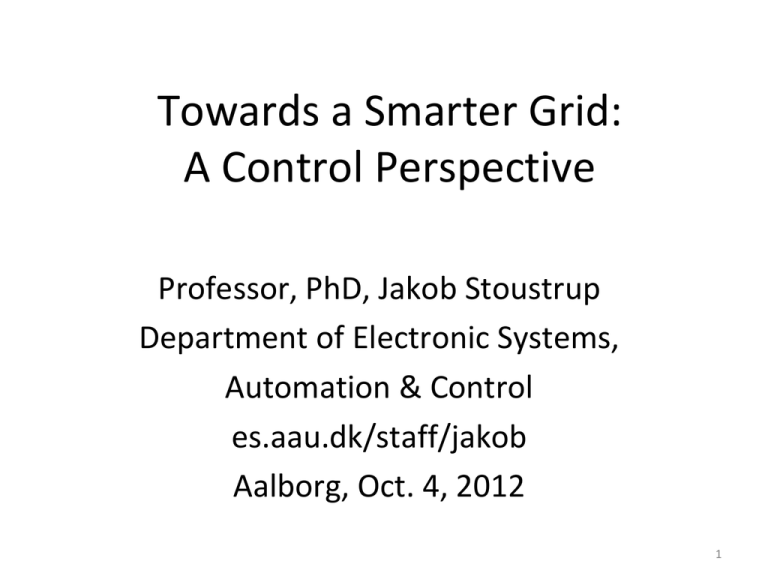
Towards a Smarter Grid: A Control Perspective Professor, PhD, Jakob Stoustrup Department of Electronic Systems, Automation & Control es.aau.dk/staff/jakob Aalborg, Oct. 4, 2012 1 Why we need smart grid control… 2 Why we need new ctrl. architectures… 3 Why we need short term control… 4 Virtual Power Plants 5 Hierarchical control of distributed energy resources 6 Ctrl of distributed energy resources 1 4 4 0.5 2 2 0 0 0 3 2 1 0 6 4 10 1 4 5 0.5 2 0 0 0 8 6 4 2 0 10 8 6 4 2 0 1 2 10 1 5 0 0 8 6 4 2 0 8 6 4 2 0 2 0 5 0 0 500 1000 0.5 0 6 4 2 0 1 0.5 0 2 8 6 4 2 0 1 0 0 500 1000 0 500 1000 0 500 1000 7 Imbalance mitigation by DER ctrl 8 Examples of Smart Grid Projects @ Dept. Electronic Systems, Automation & Control • • • • • • EDGE SmartC2Net IVIP iPower Smart & Cool Market Integration of Virtual Power Plants 9 EDGE: System Reserves 10 EDGE 11 SmartC2Net Enable robust smart grid control utilizing heterogeneous third-party communication infrastructures Challenges Variable communication network performance – caused by variable traffic load and accidental faults – affecting quality of input data and timeliness of control actions Security threats – due to additional network interfaces and – the use of off-the-shelf communication technology SmartC2Net SmartC2Net Consortium 8 partners from 6 European countries (AT, DK, GE, IT, PT, NL) + Expert Advisory Board (5 DSOs) - 13 - SmartC2Net IFIV: Remote control of heat pumps for smart grid purposes Purpose: to move consumption according to wind power production. Elspot prices and wind power production correlates. Balance Responsible Party (BRP) optimize Elspot purchase based on • Elspot price estimates • Weather forecast • House parameters The BRP controls the individual heat pumps. For each hour an amount of energy is bought in advance. Each house is controlled by the VPP in order keep the house temperature within a predefined band using the bought energy. The VPP calculates the possible regulating power each hour. Results Tested on 6 inhabited single family houses. Results for one house 18-19 April 2012 is shown. Spot plan power is the purchased energy for the house. Active plan power is the real time control signal to the house. Heat pump power is measured power from the heat pump. It is seen that the active plan is approximately the same as the spot plan power. The room temperature is within the comfort bounds. A low threshold value on the heated water tank temperature forces additional heat pump starts. Participants (opening) Total 35 Partners ( 32 Legal entities) 22 Industrial companies 9 SMV’s : (Develco Products, ENFOR Greentech Solutions, QEES, Greenwave Reality, Zense Technology, Nilan, Saseco) 6 following companies : ( Electronic Housekeeper, Gridmanager, KPMG, Lodam Electronics, NeoGrid Technologies, Vestfrost Solutions) 8 Large companies : DONG, Danfoss, Grundfos, Vestas, IBM, NEAS (Nordjysk Elhandel), COWI, Balslev 10 Universities and Recognized institutes 4 Danish : AAU ( Allborg University), DTI (Teknologisk Institut), DSKD (Kolding Designskole), DTU (Risoe, CET, IMM, MAN) 5 International : (Lund, Dublin, Illinois, Berkley, National Consumer Research Center -Finland) 1 Organization : DE (Dansk Energi - DEFU) Project Packages overview WP 0 Platform Management • Basic research • Business research • IPR driven research Jacob Østergaard WP 1 Domestic Demand Response WP 2 Industrial Demand Response WP 3 Distribution Grid Operation WP 4 Control and Market Operation WP 5 Socio-economic and Investor Evaluation WP 6 Consumer Behaviour WP 7 Information Sharing Platform Anders Troi • Test and demonstration • Networks • Business models Frank Elefsen Smart & Cool: Adaptive balancing of consumption in supermarkets The overall goal of the project is to allow an increase in penetration of wind energy in the power grid. This will be realized by the optimal distribution of consumption in refrigeration systems and electricity production. Participants: •DONG Energy •Danfoss •DTUIMM •AAU, ES, Automation & Control •KVCA Size: •4 PhD students 4 PhD students • • • • flexibility in energy consumption (cool) - at AAU flexibility in consumption and production (cool-smart) - at DTU flexibility in energy production and consumption (smart-cool) - at AAU flexibility in energy production (smart) - at AAU Market Integration of Virtual Power Plants Industrial PhD student: Mette Kirschmeyer Petersen Partners: DONG Energy, Aalborg University Challenge: how to aggregate distributed energy resources optimally



